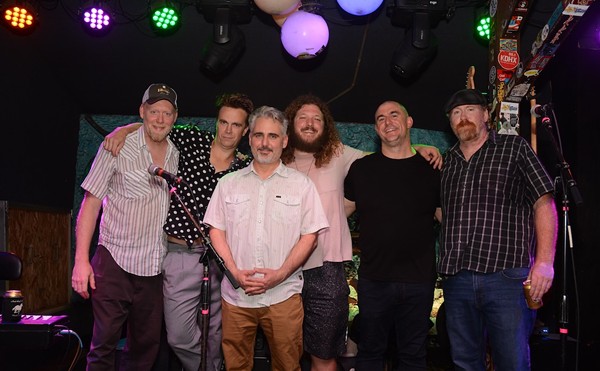Bassist Darin Gray tells the story of playing on Chicago composer Jim O'Rourke's 1997 album Bad Timing with a sense of baffled pride; asked to contribute to the album, Gray drove up from his home in Alton, Ill., to Chicago on short notice, and when the recording was finished, says Gray, "With the exception of the end of that record, where the country stuff sort of comes in, I played one note. It's fascinating to think someone would have me travel to play one note. I played one note over and over. But the more that I record and play with people, the more I realize that it's really hard to get someone to play one note. There's a lot of ego involved in music. To play one note — what are you doing? It's not impressive. If it was in Bass Player magazine, no one would be impressed by it. That's what I really like about it. (But) I used to really have a problem with that. "A monkey could do this' is what I'd think."
Gray laughs, then adds: "It was a good note."
But there's a reason Jim O'Rourke — who has composed music for the Kronos Quartet, the ROVA Saxophone Quartet and Faust; produced work by, among many others, Stereolab, John Fahey and Superchunk; and released more than a dozen albums — dragged Gray 300 miles to play one note: "Part of it is, of course, a certain way someone plays something," says O'Rourke. "But also it's a question of support, and I would rather have Darin involved, even in a little way, than not at all. At the time I even owned a double bass — I played bass for about eight years when I was younger but only do it occasionally now — but I thought it was best to get Darin involved, as a sign of, I don't know, I guess you could say solidarity, not meaning that politically."
Chicago bassists, of course, would stumble over each other to perform on an O'Rourke record, but not all bassists are as magical as Gray. And if you seldom hear such praise uttered in reference to the anchor of your basic rock or jazz ensemble — the bass seldom exudes the personality that the guitar, vocals, saxophone do — you've never heard Darin Gray play the instrument.
His work, first with the explosive, jarring rock band Dazzling Killmen, then as a member of the subtle, curious experimental three-piece You Fantastic! (along with Chicagoan Thymme Jones and fellow ex-Dazzling Killmen member Tim Garrigan, whose likewise adventuresome work will be examined in depth in the coming month), Gray has followed nothing but his instincts, and the result has been subtle transcendence. Equally impressive is his work on the regional and national scale: In addition to his work with O'Rourke — both his solo records and as part of the band Brise-Glace — he's recorded with songwriter Will Oldham, a.k.a. Palace, and worked with Japanese guitarist K.K. Null and his project Zeni Geva. And these days he travels to New York City once a month to improvise with guitarist Loren MazzaCane Connors at the respected avant-jazz linchpin the Knitting Factory.
If you ever saw Dazzling Killmen perform live during their existence, 1991 through 1996, chances are you remember Darin Gray. His presence was fierce, both physically and musically. From the get-go, his adrenaline was dripping. His whole body would contort as he slammed the bass strings. One moment he'd be standing there in, as he still calls it, "the zone," seeming to burrow holes into a brick wall (and, were it possible, succeeding, if only as a result of the intensity of his gaze); the next he'd be airborne and, upon landing, would again contort his torso with the music. At times it was scary. At other times he looked, well, weird, like maybe he was getting into it a bit too much. He looked crazy. Musically, rather than simply follow a bass pattern with a few choice notes, Gray would construct complicated rhythms, examining the outer regions of his instrument in a fashion usually reserved for the guitarist.
Dazzling Killmen could be frustrating: They were masters of discovering in-tense punk grooves, but seldom did they care about sticking with them. Rather, they'd uncover one, examine it quickly, then move onto the next. Songs jerked the listener around and as a result kept the audience off-guard and, well, frustrated. His next project, You Fantastic!, seemed to veer in the exact opposite direction: discovering a single melodic phrase, then dissecting and recontextualizing it over the course of 15 or 20 minutes.
"I don't see the difference in it, really," says Gray. "It was still sort of examining something through a microscope in the same way, whether it's a short amount of time or a long amount of time. With those short changes we were kind of developing something, although over a longer period of time. There may have been a lot of short changes, but there was a bigger picture to it. Now the stuff I've been doing doesn't have a lot of changes, but it's similar. It's still like developing over a longer period of time."
The best You Fantastic! release, Pals, is a stunning, visionary piece of work centered around one beautifully skewed Garrigan guitar line repeated over and over. Not rock, not jazz, not classical, it exists in its own musical world. The most recent, unbearably long (at least in relation to the quickie debut, Riddler, and the similarly short Pals) Homesickness is a mess of tape cuts, pure noise, gorgeous melody and conversations culled from the entirety of their work together. But the mess also illustrates the remarkable scope of the band. "Thymme Jones did Homesickness. He put that entire record together. It's funny, because he put that together without very much support even from me and Tim. He sent us a version, we got together, we listened to the tape, we picked what we liked and then Thymme started assembling it from Chicago. He sent us a rough mix tape, and we were just not getting it at all. We were bummed out and pretty much groaned when we talked to (him). It wasn't that we hated it, but it was really tough to listen to. Thymme got my feedback; I did everything but send him death threats. It was really a tough time."
Gray has been working closely with the exquisite New York guitarist MazzaCane Connors, improvising as a duo both locally and, monthly, at the Knitting Factory in New York City. Their first release together, The Lost Mariner, is due in stores this month. The prolific MazzaCane Connors has worked with Sonic Youth guitarists Thurston Moore and Lee Ranaldo, has collaborated with fellow guitarist Alan Licht (they recorded the stunning Hoffman Estates CD, on which Gray also appears, last year) and is one of the most emotive, introspective solo electric guitarists working in music today.
"I remember reading about him a long time ago in (the seminal Boston music magazine) Forced Exposure when he used to record as Guitar Roberts, and I remember then looking for his records, (but) I never could find them and I kind of just gave up after a while. When I was in Europe, I think in '93, with Brise-Glace, a friend of mine was playing his music and it just really struck me, something I really felt. And it had been a long time since I had heard something that really touched me that deeply — it tied a lot of things that were sort of loose knots. All of the music that I had kind of been into kind of all came together for me when I heard this music — just the fact that it wasn't a bad thing to be emotional and express yourself."
On The Lost Mariner, Gray and Mazza-Cane Connors improvise seemingly with one mysterious mind. Neither leads, neither follows. Rather, the guitar and bass float along melodically in a sort of beautiful, pensive netherworld. The seven pieces are abstractions, but not in a messy Jackson Pollock kind of way; they're more like Mark Rothko paintings, gentle but powerful, neat without being rigid. Live, Gray still exists in his "zone," but he no longer has the anger on his face that was always evident while he was playing with Dazzling Killmen. Now his features are softer, as if he's in a creative world that's no longer threatening but still retains a sense of danger and curiosity.
Gray's improvisations, both solo and with collaborators, take a steady ear and patience to appreciate. Seldom does his music have the in-your-face impact of his work with Dazzling Killmen. Instead, he stretches the density over the course of long musical examinations, and the results are, at times, initially allusive. In a bar setting, their relative silence and pace seem incongruous with the atmosphere — this music would be best heard in a concert hall, or in recording. But the music seeps into the psyche, its density penetrating deep and revealing itself over time. It's gorgeous music.





